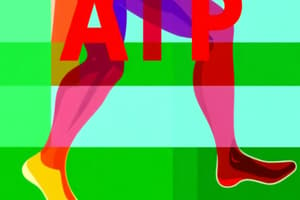Podcast
Questions and Answers
How does an increase in H+ concentration within muscle tissue inhibit metabolic processes during intense exercise?
How does an increase in H+ concentration within muscle tissue inhibit metabolic processes during intense exercise?
- By enhancing the activity of key metabolic enzymes, leading to accelerated ATP production.
- By interfering with the enzyme phosphofructokinase (PFK), reducing the rate of glycolysis. (correct)
- By promoting the efficient removal of lactate, thus preventing metabolic acidosis.
- By directly stimulating the formation of cross-bridges between actin and myosin filaments.
Which of the following roles of lactate is most crucial for sustaining energy production during prolonged aerobic exercise?
Which of the following roles of lactate is most crucial for sustaining energy production during prolonged aerobic exercise?
- Inhibiting mitochondrial growth to prevent over-oxidation of substrates.
- Preventing the formation of acetyl-CoA, thus conserving carbohydrate stores.
- Serving as a major precursor for gluconeogenesis, helping to maintain blood glucose levels. (correct)
- Acting as a signaling molecule to trigger anaerobic glycolysis.
What is the primary limitation of oxidative metabolism in supplying ATP during short bursts of high-intensity exercise?
What is the primary limitation of oxidative metabolism in supplying ATP during short bursts of high-intensity exercise?
- The complete reliance on carbohydrate substrates, which are quickly depleted.
- The inhibition of the Krebs cycle by high concentrations of H+.
- The insufficient oxygen supply to the mitochondria to meet the ATP demand rapidly. (correct)
- The slow rate of acetyl-CoA formation from pyruvate.
During the electron transport chain (ETC), how are coenzymes like NADH and FADH2 involved in ATP formation?
During the electron transport chain (ETC), how are coenzymes like NADH and FADH2 involved in ATP formation?
What is the fate of pyruvate in the absence of sufficient oxygen, and how does this process contribute to continued energy production?
What is the fate of pyruvate in the absence of sufficient oxygen, and how does this process contribute to continued energy production?
During intense exercise, what role does the regeneration of NAD (Nicotinamide Adenine Dinucleotide) play in the process of non-oxidative glycolysis?
During intense exercise, what role does the regeneration of NAD (Nicotinamide Adenine Dinucleotide) play in the process of non-oxidative glycolysis?
Which of the following scenarios would most likely benefit from creatine supplementation, according to the information provided?
Which of the following scenarios would most likely benefit from creatine supplementation, according to the information provided?
During a high-intensity, short-duration activity like a 100-meter sprint, which energy system is predominantly utilized?
During a high-intensity, short-duration activity like a 100-meter sprint, which energy system is predominantly utilized?
How does hexokinase contribute to non-oxidative glycolysis within muscle cells during intense exercise?
How does hexokinase contribute to non-oxidative glycolysis within muscle cells during intense exercise?
Phosphocreatine (PCr) acts as an immediate energy buffer during intense exercise by:
Phosphocreatine (PCr) acts as an immediate energy buffer during intense exercise by:
During high-intensity exercise, what is the primary reason that non-oxidative glycolysis cannot be sustained indefinitely, despite its rapid ATP production?
During high-intensity exercise, what is the primary reason that non-oxidative glycolysis cannot be sustained indefinitely, despite its rapid ATP production?
Why is the phosphagen system considered to have a limited capacity for prolonged, high-intensity exercise?
Why is the phosphagen system considered to have a limited capacity for prolonged, high-intensity exercise?
Creatine supplementation is a common strategy to enhance the phosphagen system. How does increased creatine availability potentially improve performance in short-duration, high-intensity activities?
Creatine supplementation is a common strategy to enhance the phosphagen system. How does increased creatine availability potentially improve performance in short-duration, high-intensity activities?
If glycogen breakdown yields a net gain of 3 ATP via non-oxidative glycolysis, how does this compare to the net ATP gain from glucose breakdown under the same conditions, and why?
If glycogen breakdown yields a net gain of 3 ATP via non-oxidative glycolysis, how does this compare to the net ATP gain from glucose breakdown under the same conditions, and why?
If an athlete requires sustained energy over a 30-minute period, which energy system would be the MOST critical?
If an athlete requires sustained energy over a 30-minute period, which energy system would be the MOST critical?
Flashcards
Phosphagen System
Phosphagen System
Supplies ATP at a high rate but for a short duration.
Glycolytic System
Glycolytic System
Supplies ATP for a moderate duration.
Oxidative System
Oxidative System
Supplies ATP at a slower rate but for a long duration.
Phosphocreatine's Role
Phosphocreatine's Role
Signup and view all the flashcards
Phosphagen Use
Phosphagen Use
Signup and view all the flashcards
Non-Oxidative Glycolysis
Non-Oxidative Glycolysis
Signup and view all the flashcards
Carbohydrate Fuels
Carbohydrate Fuels
Signup and view all the flashcards
Glycolysis
Glycolysis
Signup and view all the flashcards
Glycogenolysis
Glycogenolysis
Signup and view all the flashcards
Lactate Dehydrogenase (LDH)
Lactate Dehydrogenase (LDH)
Signup and view all the flashcards
Effect of H+ build-up
Effect of H+ build-up
Signup and view all the flashcards
Lactate's Metabolic Roles
Lactate's Metabolic Roles
Signup and view all the flashcards
Oxidative Metabolism
Oxidative Metabolism
Signup and view all the flashcards
Mitochondria Function
Mitochondria Function
Signup and view all the flashcards
Pyruvate to Acetyl CoA
Pyruvate to Acetyl CoA
Signup and view all the flashcards
Study Notes
- Several energy systems supply ATP at different rates and durations, depending on the activity.
Sarcolemma and Energy Systems
- ATP is converted to ADP in the cytosol near the sarcolemma
- Phosphagen occurs in the cytosol, utilizing 1 reaction
- Glycolytic occurs in the cytosol, utilizing 10 reactions
- Oxidative occurs in the mitochondria, utilizing greater than 10 reactions
Energy Systems: Rate vs Duration
- Phosphagen:
- Produces more ATP
- Availability is limited
- Glycolytic:
- Can be relied on for a longer period
- Oxidative:
- Operates over a longer time period
Phosphagen Stores
- Phosphocreatine "buffers" decreases in ATP immediately.
- The process is instantaneous, but the substrate is quickly depleted, limiting continuous use.
- Only one unit of ATP is formed per unit substrate; burns quickly.
Phosphocreatine: Immediate Energy
- Creatine comes from meat consumed.
- Buffers decline with ATP
- It's close to the site of ADP accumulation in the cytosol
- Reliance is limited over a long period.
- ATP converts to Adenosine with 3 phosphates
- PCr converts to creatine with 1 Phosphate
- Creatine Kinase facilitates the movement between PCr + ADP and ATP + Cr
Reliance on Phosphagen Stores
- Rely on phosphagen stores during:
- First 15 seconds of intense/forceful movements.
- "Rest-to-work" transitions.
- Workload transitions during exercise.
- It takes 5-10 minutes to replenish phosphagen stores.
Creatine Supplementation
- Basic theory: increased Cr + ATP leads to ADP + PCr.
- 90% of creatine storage is in skeletal muscle.
- Supplementation may work in some cases, particularly for those who rely on the PCr system, in brief, intense, repeated exercise and for older adults.
- Problems include:
- Weight gain.
- Fluid balance issues; supplement may cause water retention in muscles.
- Creatine may end up somewhere else other than the muscles.
Non-Oxidative Glycolysis
- Involves a partial breakdown of glucose/glycogen without oxygen.
- Process is rapid but limited by metabolic by-products.
- It generates 2-3 units of ATP per unit of substrate.
Carbohydrate Fuels: Glucose & Glycogen
- Glucose has the chemical formula C6H12O6.
- Glycogen is a glucose polymer.
Glucose and Glycogen Catabolism
- Glycolysis involves the breakdown of one glucose molecule to form two pyruvate molecules.
- Glycogenolysis involves the breakdown of one "glucose unit" (6-C) from glycogen to glucose-1-phosphate.
"Glycolytic System": Key Points
- GLUT transporter allows glucose into the muscle during exercise.
- Hexokinase traps glucose in the muscle.
- Phosphofructokinase (PFK) is a key enzyme.
- Substrate-level phosphorylation generates ATP in the absence of oxygen.
- NADH is an important high-energy substrate used in the ETC to generate ATP.
- Net ATP gain is:
- 2 for glucose
- 3 for glycogen
- The liver can take G6-P into glucose.
Fate of Pyruvate
- Pyruvate can turn into lactate:
- Via lactate dehydrogenase (LDH).
- This process is anaerobic.
- NAD is essential to continue glycolysis.
- Pyruvate can turn into acetyl CoA:
- Via pyruvate dehydrogenase (PDH), which is an enzyme.
- This process is oxidative.
- Occurs in mitochondria.
Lactate Formation from Pyruvate
- Lactate formation from pyruvate regenerates NAD.
Reliance on Non-Oxidative Glycolysis
- Heavily relied on during:
- Intense exercise.
- "Rest-to-work" transition.
- Workload transitions in exercise.
Increased Lactic Acid
- Increased lactic acid can be a potential problem due to the buildup of H+.
- H+ significantly affects muscle pH.
- Leads to a decrease in muscle pH resulting in:
- Metabolic inhibition, decreasing enzyme activity and the ability to continue the pathway, as H+ interferes with PFK.
- Contractile inhibition, decreasing crossbridge cycling and interfering with actin & myosin, which reduces efficiency in crossbridge formation.
Lactate as a Fulcrum
- Lactate anion is formed under fully aerobic conditions.
- Major source for mitochondrial respiration.
- Functions as a major gluconeogenic precursor and signaling molecule.
- Stimulates mitochondrial growth.
Oxidative Metabolism
- Involves a complete breakdown of CHO, fats, and AAs to CO2 and H2O.
- Strips all potential energy from carbs & fats for efficient energy use.
- Requires oxygen for sustained energy.
- Essential processes occur in the mitochondrion.
- Generates over 30 units of ATP per unit substrate.
Mitochondria
- The powerhouse of the cell.
- H+ is pumped across the intermembrane.
Oxidative Metabolism: Essential Steps
- Formation of acetyl CoA from CHO, fat, or AA.
- It is universal and comes from any substrate.
- Oxidation of acetyl CoA (Krebs cycle).
- Coenzymes are reduced.
- NAD+
- FADH
- Loss of electron - oxidize
- Gain of electron - reduction
- Coenzymes are reduced.
- Formation of ATP via the electron transport chain:
- Coenzymes are oxidized.
- Complexes in the ETC are reduced.
- It's hard to do during high intense exercise.
Carbohydrate Oxidation
- Pyruvate + NAD converts to acetyl coA + CO2 + NADH, using pyruvate dehydrogenase.
- In the absence of oxygen, the fate of pyruvate is lactic acid.
- Pyruvate dehydrogenase is an enzyme in mitochondria.
- NADH is:
- Used in oxidative phosphorylation.
- Found in glycolysis and used in the ETC.
- During anaerobic conditions, NADH oxidizes to NAD, and lactate regenerates NAD.
Krebs Cycle/TCA/Citric Acid Cycle
- More NADH is generated, leading to 3 ATP in the ETC.
- FADH2 is generated, leading to 2 ATP in the ETC.
- ATP is also generated.
- Citrate synthase is used.
Electron Transfer: Oxidation & Reduction
- Oxidation involves the loss of electrons.
- Reduction involves the gain of electrons.
- The electron transport chain carries electrons as H atoms.
Electron Transport Chain
- Involves a series of oxidation-reduction reactions.
- Electrons are passed from NADH and FADH2 to O2.
- Cytochrome oxidase transfers H+ to O2 to create H2O.
- ATP synthase facilitates the generation of ATP at the end of the ETC.
Oxidative Phosphorylation
- Generation of ATP is due to movement of H+ ions across the membrane.
- Accounting for transport of ATP:
- NADH = 2.5 ATP
- FADH2 = 1.5 ATP
Maximum Aerobic ATP Yield
- The values shown are for starting with 1 x 6-C “glucose unit” cleaved from glycogen:
- Glycolysis: 3 ATP (total if anaerobic), 2 NADH.
- Pyruvate dehydrogenase reaction: 2 NADH.
- TCA/ETC: 6 NADH, 2 FADH2, 2 ATP.
Fat Oxidation - Triglyceride Structure
- Main sources are adipose tissue and skeletal muscle.
- The basic structure contains glycerol.
Stages of Lipid Catabolism
- Mobilization – TG breakdown (“lipolysis” in adipose tissue/muscle
- Transport – FA in blood via albumin to skeletal muscle
- Uptake – FA enters muscle cytosol
- Activation – FA “prepared” for breakdown by mitochondria
- Uptake - FA enters mitochondria
- Beta-oxidation – FA is broken down in mitochondria
- Mito oxidation – TCA cycle/ETC activity
FA Mobilization
- Hormone-sensitive lipase (HSL) stimulates this and is stimulated by:
- Lack of glucose.
- Hormones (epi/norepinephrine).
- Cortisol increasing HSL
- Insulin shuts off HSL
- 3 FAs turn into the muscle to catabolize for energy
- Glycerol turns into Liver converted to glucose
FA Transport, Uptake & Activation
- Fatty acetyl-CoA is recognizable by mitochondria.
- Carnitine palmitoyl transferase (CPT) shuttles FA to mitochondria in order to activate.
- Carnitine (acts as an escort):
- Is a Key component of CPT
- Without this, cannot use Fatty Acids for energy
- Becomes unavailable during high intense exercise
Carnitine as a Weight Loss
- Carnitine does NOT work.
- The supplement wants to end up in Mitochondria tissues of interest
Beta Oxidation
- Key points:
- Key step Before TCA
- 2c become an acetyl-coa goes through B-oxidation
- Goes through 7x remain final 2C
- Number of Carbons divided by 2-1
ATP Yield
- Each "Turn" of B-oxid requires
- 1 FADH- 1.5 ATP
- NADH- 2.5 ATP
- 1 Acetyl-COA requires 10 ATP
- Remaining 2C unity
Performance
- If CHO isn't used as a substrate, for elite athlete performance, during events longer than 30s-4 hours, there may be decreased performance
Protein Metabolism - Breakdown
- AA are used as fuel by - removing amino group
- Major site- Liver
- Minor Site- Skeletal muscle
- Oxidation of remaining “Carbon Skeleton” (“oxo acid”) - Eventually from Pyruvate or Acetyl COA
- Major AA in Exercise - BCAA (Leucine, Isoleucine, Valine) - Alanine, Glutamine
- *Draw out BCAA example
Gluconeogenesis : Recycling
- Gluconeogenesis — formation of “New Glucose” from metabolic Intermediates
Studying That Suits You
Use AI to generate personalized quizzes and flashcards to suit your learning preferences.




